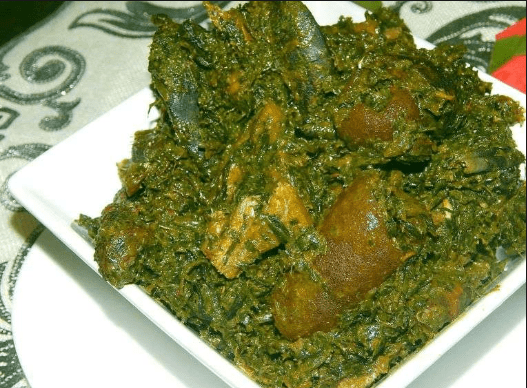AFANG SOUP (History and Ethnic Variation – Calabar, Ibibio/Anang, etc.)
In this episode of “Naija On A Plate”, we are taking a trip down to the southern part of Nigeria where we will present and examine one of the more popular native dishes known as “Afang Soup”. We will also highlight the diverse variations of this dish as well as the ethnic groups involved.
Afang soup also known as African Salad is a delicious vegetable soup mainly eaten in the southern part of Nigeria i.e the Efik tribe or Calabar people of Cross River State, the Ibibio/Anang and Ndoki tribes of Akwa Ibom State, some northern local government areas in Cross River State as well as some other African countries i.e Cameroon, Gabon, Congo and Angola.
It is a pocket friendly soup that features in almost all Nigerian events/ ceremonies in the southern region. It can also be easily assessed in eateries, restaurants and fast foods all over the aforementioned states.
Afang Soup consists of two main leaves; “afang leaf” and “water leaf”. The Afang leaf is known to the Igbo’s as “okazi or ukazi”, some Bakor speaking communities as “eru” and the English as “African Jointfir”.
Afang leaf is a climbing leaf that grows naturally in the rain forest and its botanical name is Gnetum africanum from the family Gnetaceae. While the water-leaf also known botanically as Talinum triangulare is an edible leafy vegetable that could either be cultivated by humans or grows freely as a weed. In its absence, it could be substituted for other leaves from the same botanical family such as Malabar spinach (Amunututu), watercress, lamb’s leaf lettuce (best substitute) or any other water rich spinach.
We will examine three major recipes of this soup which are the Calabar recipe, the Ibibio recipe as well as the recipe of the Northern/ Central Cross-Riverians i.e. the Yala, Ogoja and Ikom people.
IBIBIO/ ANANG RECIPE
In the Ibibio recipe it will be prudent to note the presence of unshelled periwinkles. The Ibibio or Anang man sees an afang soup as incomplete without the presence of periwinkles because of it’s abundance in their riverine settlements. Also, an Ibibio or Anang man will rarely cook any dish without the presence of onions in it, hence the onions will be diced into pieces and added to the water-leaf before cooking. It is also used in steaming of meats and other orishirishis.
CALABAR RECIPE
Due to the closeness of the Calabar people to the sea/ river. Almost all their protein contained meals are either made up of sea foods or garnished with sea foods.
The Calabar recipe is almost similar to that of the Ibibios/ Anang except for the absence of unshelled periwinkles.The Efik/ Calabar person will rather substitute the unshelled periwinkles for either snails, prawns, clams or shelled periwinkles.
NORTHERN/ CENTRAL CROSS-RIVERIAN RECIPE (ATAM,EKOI/ EJHAGHAM)
The recipe of the Yala, Ogoja and Ikom people usually include the addition of groundnuts/peanuts, dawadawa/ African locust beans and sometimes melon or egusi. This version of afang soup is either known as groundnut afang soup if groundnuts are used or egusi afang soup if egusi is used.
It could be prepared by either adding grinded/blended roasted groundnut to the normal afang soup recipe or cooking the groundnut paste with thinly sliced afang leaves, dawadawa etc but with the absence of waterleaf.
The above mentioned groundnut soup recipes can also be used for “egusi afang”.
Follow this series by subscribing to get notifications on latest post and updates.






Background knowledge of your favourite meal is key.
Thanks for the enlightenment.
Chef Bee
Very interesting to note; But why is it call A salad when it is mainly a soup?
Yes it’s mainly a soup but there are also different types of salads. So therefore it has been considered an African salad by some because it contains copious amounts of fresh vegetables especially the waterleaf which is a type of spinach. The Spinach/lettuce is a major aspect of salads worldwide, also the soup contains various forms of protein as well as an oil dressing. I hope this explanation has answered your question dear foodie.
[…] NAIJA ON A PLATE: AFANG SOUP Part 1 (History & Ethnic Variations) […]
[…] LEARN THE HISTORICAL BACKGROUND OF AFANG SOUP… […]
Yes it’s mainly a soup but there are also different types of salads. So therefore it has been considered an African salad by some because it contains copious amounts of fresh vegetables especially the waterleaf which is a type of spinach. The Spinach/lettuce is a major aspect of salads worldwide, also the soup contains various forms of protein as well as an oil dressing. I hope this explanation has answered your question dear foodie.
Like!! I blog frequently and I really thank you for your content. The article has truly peaked my interest.
Thank you ever so for you article post.
A big thank you for your article.
bookmarked!!, I like your blog!